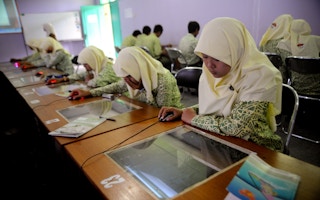Advances in information and communication technology (ICT) have been instrumental in shaping and leading socioeconomic transformations across Asia and the Pacific.
One key to this transformation is the technology bundled around the Internet of Things (IoT), which enables billions of devices and appliances to connect over the Internet for more accurate, real-time data collection and analysis on an unparalleled scale.
For instance, through Internet-connected sensors attached to equipment, facilities and infrastructure, early-on maintenance alarms can be raised for potential problems, such as defects or wear and tear, thereby potentially saving the lives of those using them. Another example is devices on farms that remotely monitor soil conditions, weather, and pesticide use for more rapid and better-informed decision making.
Despite an increasing spotlight on the transformative capabilities of newer technologies such as the IoT, the Asia-Pacific region nevertheless still suffers from a lack of ICT connectivity, and the digital divide in our region continues to be one of the largest in the world.
As a powerful tool with the potential to address development challenges, ICT has the potential to foster equality and inclusiveness in our region. Recognising this, the Sustainable Development Goals (SDGs) acknowledge ICT as a development enabler and the foundational infrastructure for achieving sustainable development. In this context, enhancing access to affordable, reliable, resilient and robust broadband connectivity must be seen as a prerequisite for accelerated and inclusive development in the Asia-Pacific region.
A fundamental challenge related to new business opportunities and innovations that IoT and other ICT advancements generate is how to best connect those who are still unconnected, so that they too can reap the benefits of these advances.
The United Nations Economic and Social Commission for Asia and the Pacific (ESCAP) underscored the need to address this challenge in a recent report entitled the State of ICT in Asia and the Pacific 2016: Uncovering the Widening Broadband Divide. The report highlighted the alarming disparity in broadband connectivity within Asia-Pacific, with high-income countries experiencing a higher growth rate of broadband penetration relative to other countries.
Twenty countries in the region have only two per cent of fixed broadband subscription per 100 inhabitants, while ICT champions such as the Republic of Korea enjoy over 40 per cent broadband penetration. Further emphasising regional disparities, 75 per cent of fixed broadband subscriptions were registered in North and North-East Asia, mainly in the People’s Republic of China, the Republic of Korea, and Japan.
Broadband connectivity - especially reliable, affordable and resilient fixed broadband infrastructure - is a critical foundation which supports various applications and initiatives that are essential for the achievement of the SDGs, ranging from traffic and transport management, smart power management, trade facilitation, disaster management and financial inclusion, to name only a few. ICT is not only a growth sector which creates value-added services, products and employment opportunities, but it also acts as a development enabler which can accelerate efforts towards the implementation of the SDGs.
While success stories in e-commerce abound, such as China’s Alibaba, less is known about the use of ICT for socioeconomic benefits, such as mobile money in Pakistan and the Philippines where salaries and remittances are sent over mobile phones. Farmers and rural residents increasingly use the Internet, allowing them to gain unparalleled access to information and knowledge and helping to further develop multiple sectors, such as agriculture, education, and health.
ICT also plays a crucial role in disaster management. When a disaster strikes, it is the telecommunications infrastructure which provides the platform to communicate with those in need of help, and collect and analyse data on losses and damage to facilitate disaster response and reconstruction.
Moreover, ICT can facilitate social integration of marginalised groups, such as people with disabilities, by providing them with more effective means to communicate and engage in a wider variety of socioeconomic activities. At the same time, however, the region needs a development pathway to the digital economy and future prosperity for inclusive and sustainable development.
While significant efforts have gone towards expanding broadband connectivity at national and sub-national levels, the Internet is inherently regional as well as global, therefore affordable and reliable connectivity to regional and global telecommunications networks are indispensable for narrowing the digital divide through better connectivity.
The Asia-Pacific region is particularly impacted by the widening digital divide due to its vulnerability to frequent catastrophic disasters, which cause massive destruction to life and property. Earthquakes, for instance, have disrupted submarine cables and subsequently, access to the Internet among densely populated coastal areas and cities. Learning from the lessons and moving forward, the region urgently needs to improve, enhance and expand its broadband connectivity to provide alternative routes and networks to build greater regional resilience to disasters.
“
ICT is not only a growth sector which creates value-added services, products and employment opportunities, but it also acts as a development enabler which can accelerate efforts towards the implementation of the SDGs.
In this context, ESCAP supports the Asia-Pacific Information Superhighway (AP-IS), a regional broadband connectivity initiative mandated by member countries that aims to enhance connectivity from Turkey to Kiribati in a holistic manner with its four pillars: enhancing physical connectivity, effective Internet traffic management, e-resilience, and inclusive broadband access.
Given the regional and global nature of the initiative, ESCAP provides an inter-governmental platform for member countries to discuss the regional cooperation framework and implementation of the AP-IS Master Plan to further deepen regional connectivity and maximise the socio-economic benefits for all.
ESCAP’s Committee on Information and Communications Technology, Science, Technology and Innovation, scheduled from 5 to 7 October 2016 in Bangkok, is one such regional platform to engage member countries and other stakeholders in discussions contributing to a regional vision of what ICT can and should do for the region’s future.
It is imperative that we enhance connectivity, since without effective and viable “people connections”, the region’s full potential will not be realised.
Dr Shamshad Akhtar is an Under-Secretary-General of the United Nations and Executive Secretary of ESCAP. The full text of the new ESCAP report on the “State of ICT in Asia and the Pacific 2016: Uncovering the Widening Broadband Divide” will be available at: http://www.unescap.org/resources/state-ict-asia-and-pacific-2016-uncovering-widening-broadband-divide


















